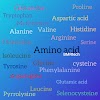Phenylalanine | Introduction | History | Structure | Industrial Function.....
PHENYLALANINE AMINO ACID
Phenylalanine (symbol Phe or F)[2] is an essential α-amino acid, It can be viewed as a benzyl group substituted for the methyl group of alanine, or a phenyl group in place of a terminal hydrogen of alanine.
Or
Phenylalanine is an essential aromatic amino acid in humans (provided by food), Phenylalanine plays a key role in the biosynthesis of other amino acids and is important in the structure and function of many proteins and enzymes.
Phenylalanine is converted to tyrosine, used in the biosynthesis of dopamine and norepinephrine neurotransmitters. The L-form of Phenylalanine is incorporated into proteins, while the D-form acts as a painkiller. Absorption of ultraviolet radiation by Phenylalanine is used to quantify protein amounts. This essential amino acid is classified as neutral, and nonpolar because of the inert and hydrophobic nature of the benzyl side chain. The L-isomer is used to biochemically form proteins, coded for by DNA. Phenylalanine is a precursor for tyrosine, the monoamine neurotransmitters dopamine, norepinephrine (noradrenaline), and epinephrine (adrenaline), and the skin pigment melanin. It is encoded by the codons UUU and UUC. Phenylalanine is found naturally in the breast milk of mammals. It is used in the manufacture of food and drink products and sold as a nutritional supplement for its reputed analgesic and antidepressant effects. It is a direct precursor to the neuromodulator phenethylamine, a commonly used dietary supplement.
Properties :-
Chemical formula :- C9H11NO2
Molar mass :- 165.192 g·mol−1
Acidity (pKa) :- 1.83 (carboxyl), 9.13 (amino)
Thermodynamic data :- Phase behaviour (solid–liquid–gas)
STRUCTURE :-
HISTORY :-
 |
| Schulze |
The first description of phenylalanine was made in 1879, when Schulze and Barbieri identified a compound with the empirical formula, C9H11NO2, in yellow lupine (Lupinus luteus) seedlings. In 1882, Erlenmeyer and Lipp first synthesized phenylalanine from phenylacetaldehyde, hydrogen cyanide, and ammonia. The genetic codon for phenylalanine was first discovered by J. Heinrich Matthaei and Marshall W. Nirenberg in 1961. They showed that by using mRNA to insert multiple uracil repeats into the genome of the bacterium E. coli, they could cause the bacterium to produce a polypeptide consisting solely of repeated phenylalanine amino acids. This discovery helped to establish the nature of the coding relationship that links information stored in genomic nucleic acid with protein expression in the living cell.
SYNTHESIS :-
L-Phenylalanine is produced for medical, feed, and nutritional applications, such as aspartame, in large quantities by utilizing the bacterium Escherichia coli, which naturally produces aromatic amino acids like phenylalanine. The quantity of L-phenylalanine produced commercially has been increased by genetically engineering E. coli, such as by altering the regulatory promoters or amplifying the number of genes controlling enzymes responsible for the synthesis of the amino acid.
Sources :- Dietary source - Good sources of phenylalanine are eggs, chicken, liver, beef, milk, and soybeans. Another common source of phenylalanine is anything sweetened with the artificial sweetener aspartame, such as diet drinks, diet foods and medication; the metabolism of aspartame produces phenylalanine as one of the compound's metabolites.
Derivatives :-
Boronophenylalanine (BPA) is a dihydroxyboryl derivative of phenylalanine, used in neutron capture therapy.
4-Azido-l-phenylalanine is a protein-incorporated unnatural amino acid used as a tool for bioconjugation in the field of chemical biology.
SUBSCRIBE FOR MORE INFORMATION........!







0 Comments